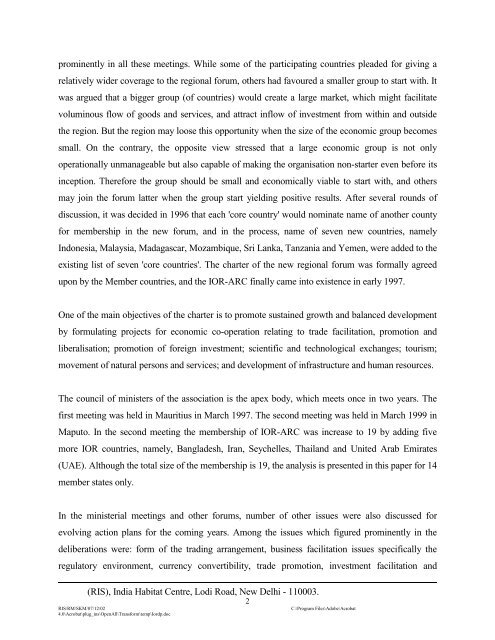dp11_pap
dp11_pap
dp11_pap
Create successful ePaper yourself
Turn your PDF publications into a flip-book with our unique Google optimized e-Paper software.
prominently in all these meetings. While some of the participating countries pleaded for giving a<br />
relatively wider coverage to the regional forum, others had favoured a smaller group to start with. It<br />
was argued that a bigger group (of countries) would create a large market, which might facilitate<br />
voluminous flow of goods and services, and attract inflow of investment from within and outside<br />
the region. But the region may loose this opportunity when the size of the economic group becomes<br />
small. On the contrary, the opposite view stressed that a large economic group is not only<br />
operationally unmanageable but also capable of making the organisation non-starter even before its<br />
inception. Therefore the group should be small and economically viable to start with, and others<br />
may join the forum latter when the group start yielding positive results. After several rounds of<br />
discussion, it was decided in 1996 that each 'core country' would nominate name of another county<br />
for membership in the new forum, and in the process, name of seven new countries, namely<br />
Indonesia, Malaysia, Madagascar, Mozambique, Sri Lanka, Tanzania and Yemen, were added to the<br />
existing list of seven 'core countries'. The charter of the new regional forum was formally agreed<br />
upon by the Member countries, and the IOR-ARC finally came into existence in early 1997.<br />
One of the main objectives of the charter is to promote sustained growth and balanced development<br />
by formulating projects for economic co-operation relating to trade facilitation, promotion and<br />
liberalisation; promotion of foreign investment; scientific and technological exchanges; tourism;<br />
movement of natural persons and services; and development of infrastructure and human resources.<br />
The council of ministers of the association is the apex body, which meets once in two years. The<br />
first meeting was held in Mauritius in March 1997. The second meeting was held in March 1999 in<br />
Maputo. In the second meeting the membership of IOR-ARC was increase to 19 by adding five<br />
more IOR countries, namely, Bangladesh, Iran, Seychelles, Thailand and United Arab Emirates<br />
(UAE). Although the total size of the membership is 19, the analysis is presented in this <strong>pap</strong>er for 14<br />
member states only.<br />
In the ministerial meetings and other forums, number of other issues were also discussed for<br />
evolving action plans for the coming years. Among the issues which figured prominently in the<br />
deliberations were: form of the trading arrangement, business facilitation issues specifically the<br />
regulatory environment, currency convertibility, trade promotion, investment facilitation and<br />
(RIS), India Habitat Centre, Lodi Road, New Delhi - 110003.<br />
RIS/RM/SKM/07/12/02 C:\Program Files\Adobe\Acrobat<br />
4.0\Acrobat\plug_ins\OpenAll\Transform\temp\Iordp.doc<br />
2
















